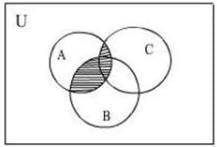Test: Operations On Sets - JEE MCQ
Test Description
10 Questions MCQ Test - Test: Operations On Sets
Test: Operations On Sets for JEE 2025 is part of JEE preparation. The Test: Operations On Sets questions and answers have been prepared
according to the JEE exam syllabus.The Test: Operations On Sets MCQs are made for JEE 2025 Exam.
Find important definitions, questions, notes, meanings, examples, exercises, MCQs and online tests for Test: Operations On Sets below.
Solutions of Test: Operations On Sets questions in English are available as part of our course for JEE & Test: Operations On Sets solutions in
Hindi for JEE course.
Download more important topics, notes, lectures and mock test series for JEE Exam by signing up for free. Attempt Test: Operations On Sets | 10 questions in 10 minutes | Mock test for JEE preparation | Free important questions MCQ to study for JEE Exam | Download free PDF with solutions
Detailed Solution for Test: Operations On Sets - Question 1
Detailed Solution for Test: Operations On Sets - Question 2
Detailed Solution for Test: Operations On Sets - Question 3
Test: Operations On Sets - Question 4
If the sets A and B are defined as A = {(x, y) : y = ex, x ∈ R}; B = {(x, y) : y = x,x ∈ R}, then
Detailed Solution for Test: Operations On Sets - Question 4
Test: Operations On Sets - Question 5
The intersection of the sets {1, 2, 5} and {1, 2, 6} is the set ______
Detailed Solution for Test: Operations On Sets - Question 5
Detailed Solution for Test: Operations On Sets - Question 6
Test: Operations On Sets - Question 7
If A = {x : x is a multiple of 3} and B = {x : x is a multiple of 5}, then A - B is
Detailed Solution for Test: Operations On Sets - Question 7
Detailed Solution for Test: Operations On Sets - Question 8
Test: Operations On Sets - Question 9
In probability, the event ‘A or B’ can be associated with set:
Detailed Solution for Test: Operations On Sets - Question 9
Test: Operations On Sets - Question 10
If A and B are two given sets, then A ∩ (A ∩ B') is equal to
Detailed Solution for Test: Operations On Sets - Question 10
Information about Test: Operations On Sets Page
In this test you can find the Exam questions for Test: Operations On Sets solved & explained in the simplest way possible.
Besides giving Questions and answers for Test: Operations On Sets, EduRev gives you an ample number of Online tests for practice
Download as PDF




















